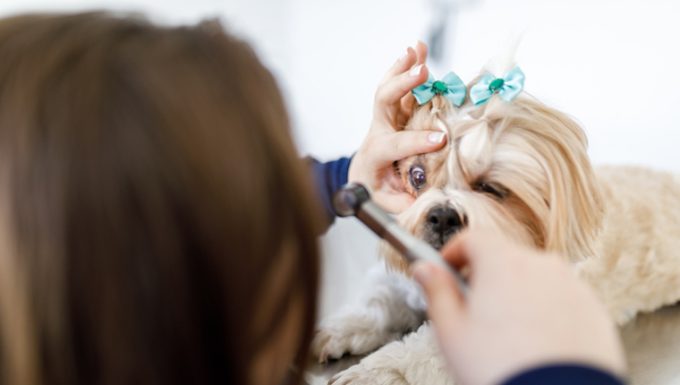Eye ulcer in dogs affects the most outer layer of the eye (called the cornea). The condition can cause pain, redness, and swelling.
Additionally, flat-faced dogs suffer from the condition the most.
Technically, the condition is also known by the medical names corneal ulcer and ulcerative keratiti. However, it’s important to note that the condition is different to nonulcerative keratitis.
If you see the signs of eye ulcer in your dog, then get to a veterinarian for a proper diagnosis and treatment.
Here’s what you should know about the symptoms, causes, and treatments for the condition.
Symptoms of Eye Ulcer in Dogs
The condition produces a wide range of symptoms. For example, some of the most common symptoms include:
- Blinking a lot
- Tearing
- Discharge (usually green or yellow)
- Swelling around the eyes
- Loss of appetite
- Vision issues
- Redness around the eyes
- Acting lethargic
Causes of Eye Ulcer in Dogs

The cause of the condition is often some sort of trauma. Additionally, the following factors can also cause the condition:
- Chemical burns
- Infection (bacterial or viral)
- Dry eye
- Neurological issues
- Endocrine problems
- Foreign body (such as sand)
Generally, flat-faced dogs develop the condition the most. These dogs are technically known as brachycephalic breeds.
Furthermore, the following breeds also seem more prone to the condition:
- Afghan Hounds
- Beagles
- King Charles Cavaliers
- Boxers
- Cocker Spaniels
Treatments for Eye Ulcer in Dogs
Firstly, your vet will ask about your dog’s symptoms. Secondly, your vet will carry out a close examination of your dog’s eyes.
A number of specific tests can be carried out to detect the severity of any eye ulcers. For instance, some of the most frequently used tests include:
- Schirmer testing (to test tear production)
- Fluorescein stain
- Cytology
- Tonometry (to test eye pressure)
Treatment for the condition will depend on its severity. For example, in some cases topical antibiotics and pain medication can be used.
As always, follow your vet’s precise dosage and frequency instructions. Also, complete the full course of medication.
In other cases, contact lenses can be used. These will protect the eye while your dog recovers.
Unfortunately, more severe cases of the condition can require a surgery. While recovering from a surgery, your dog will need to wear an Elizabethan collar. This is to protect the eyes.
Have you ever cared for a dog who suffered from this condition? How did your vet help your dog recover? Let us know in the comments section below.









